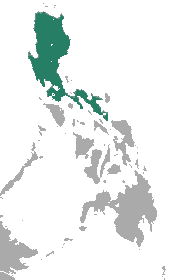Luzon fruit bat
| Luzon fruit bat | |
|---|---|
| Scientific classification | |
| Domain: | Eukaryota |
| Kingdom: | Animalia |
| Phylum: | Chordata |
| Class: | Mammalia |
| Order: | Chiroptera |
| Family: | Pteropodidae |
| Genus: | Otopteropus Kock, 1969 |
| Species: | O. cartilagonodus
|
| Binomial name | |
| Otopteropus cartilagonodus Kock, 1969
| |

| |
| Luzon Fruit Bat range | |
The Luzon fruit bat (Otopteropus cartilagonodus) is a species of megabat in the family Pteropodidae. It is the only species within the genus Otopteropus[2] and is endemic to the Philippines. Its natural habitat is subtropical or tropical dry forest.
Description[edit]
The Luzon fruit bat, a member of the order Chiroptera, is a small bat that is common to Luzon island.[3] It exhibits dark blackish brown coloration, with a lighter color appearing on the abdominal area, usually grey.[2] It is nocturnal and has rather large eyes, especially for its small stature.[2] Luzon Fruit bats are identifiable by their ears, which are marked by red thickenings.[4]
The species exhibits sexual dimorphism in their cranial characters, particularly the skull.[5] The overall size of the skull is found to be larger in males, but females have a more heightened braincase.[5] Because of this, the females have a longer total body length, while both sexes have similar wing bone length.[5]
Ecology[edit]
Distribution and habitat[edit]
The Philippine Islands have wide fauna diversity. Under the order Chiroptera, the island is home to 73 species, 36 genera, and 6 families.[5] Luzon Fruit Bats are one of two species in the family Pteropodidae that have undergone radiation in Southeast Asia.[5] The Luzon Fruit Bat is restricted to Luzon Island, found on the Philippine archipelago.[6] They occupy three different regions on this island: the Cordillera Central Mountains, the Sierra Madre Mountains, and the Zambales Mountains.[7] It has been hypothesized that these three clades diverged from one another around 1.91 million years ago.[3]
The Luzon fruit bats are more abundant in montane primary forest.[4] But they have spread to well-developed secondary forest, as well as lowland, montane, and mossy forests.[4] Their distribution is found in an elevation range from 200 – 2250 meters (Heaney et al. 1998), but regions of middle elevation is preferred.[3] Because of their high elevation location, they are listed as a Least Concern.[1]
Diet[edit]
It is frugivorous; its diet consists mainly of fruit or nectar.[4] In their consumption of fruit, they help contribute to natural reforestation by dispersing seeds.[4] Due to a difference in cranial size, males and females tend to have different food preferences, based on what is most accessible to their body shape.[5]
Behavior[edit]
Reproduction[edit]
Females have a long duplex uterus that is superficially joined at the cervix.[2] These bats produce one or two young per year.[7] And the distribution of embryo between the left and right uteri are relatively equal and no preference has been observed.[2] Research has concluded that females undergo delayed implantation, although the specific length of delay is unknown.[2]
Male members of the order Chiroptera have a wide morphological variation of primary reproductive structures.[8] Male Luzon fruit bats are no exception, as they display a form of migratory testes, in which their testes are located in the abdomen.[2] Additionally, these male bats have few spermatozoa in both their testes and epididymis, indicating that much of the sperm in not fully mature.[2]
References[edit]
- ^ a b Ong, P.; Rosell-Ambal, R.G.B.; Tabaranza, B.; Heaney, L.; Duya, P.; Gonzalez, J.C.; Balete, D.S. (2020). "Otopteropus cartilagonodus". IUCN Red List of Threatened Species. 2020: e.T15665A22122206. doi:10.2305/IUCN.UK.2020-2.RLTS.T15665A22122206.en. Retrieved 16 November 2021.
- ^ a b c d e f g h Heideman, Paul D., Jennifer A. Cummings, and Lawrence R. Heaney. "Reproductive timing and early embryonic development in an Old World fruit bat, Otopteropus cartilagonodus (Megachiroptera)." Journal of mammalogy 74.3 (1993): 621-630.
- ^ a b c Roberts, Trina E. Divergence, diversity, distance, and disequilibrium: comparative phylogeography of six Philippine fruit bats (Chiroptera; Pteropodidae). Diss. University of Chicago, Pritzker School of Medicine, Committee on Evolutionary Biology, 2005.
- ^ a b c d e Heaney, Lawrence R. "Synopsis of the mammalian fauna of the Philippine Islands." (1998).
- ^ a b c d e f Rickart, Eric A., Jennifer A. Mercier, and Lawrence R. Heaney. "Cytogeography of Philippine bats (Mammalia: Chiroptera)." Proceedings of the Biological Society of Washington 112.3 (1999): 453-469.
- ^ Alviola, Phillip A., et al. "Chapter 2: mammalian diversity patterns on Mount Palali, Caraballo Mountains, Luzon." Fieldiana Life and Earth Sciences(2011): 61-74.
- ^ a b Ruedas, L. A., J. R. Demboski, and R. V. Sison. "Morphological and ecological variation in Otopteropus cartilagonodus Kock, 1969 (Mammalia: Chiroptera: Pteropodidae) from Luzon, Philippines." Proceedings of the Biological Society of Washington 107.1 (1994): 1-16.
- ^ Beguelini, Mateus R., et al. "Morphological variation of primary reproductive structures in males of five families of neotropical bats." The Anatomical Record 296.1 (2013): 156-167.

